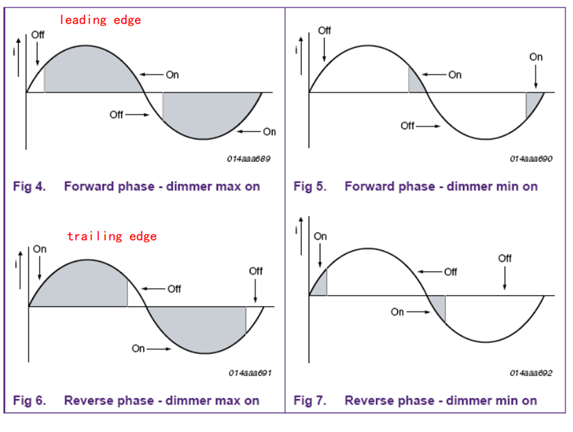Tsingko phase cut dimmable LED drivers work with both trailing edge and leading edge LED dimmers.
What's the difference between leading and trailing? You will have a rough idea in this article.
• Dimmer switch classification
Dimmer switches work by turning off power to the lighting circuit during part of the supply cycle. By rapidly (twice for each cycle of the supply voltage, or 100/120 times per second) turning the light circuit on and off, the total energy delivered to the lighting element is reduced. The longer the power is off during each cycle, the dimmer the light will be. The thermal persistence of the filament smooths out the pulses, ensuring flickering due to the rapid switching is imperceptible.
Dimmers can be divided into two operational categories: positive angle/forward phase operation, also known leading edge dimming, and negative angle/reverse phase operation, or trailing edge dimming.
Forward phase dimmers work by varying the switch ON point of the supply current to a lighting circuit. They detect the start (zero-crossing point) of each half-cycle of the supply voltage, then wait for a predetermined period before switching on the current.
Reverse phase dimmers vary the switch OFF point, cutting off the supply current to the lighting circuit at predetermined intervals.

Two switching methodologies can be distinguished: triac dimming and transistor dimming. Triac switching is always used with forward phase dimmers. Transistor switching can be used with forward and reverse phase dimmers. Transistor dimmers have the advantage of being able to switch capacitive loads, but most existing dimmers are still triac based.
• Triac dimmer (Leading edge)
A triac is a bidirectional gated switching device with distinct latching properties. A number of conditions must be met to ensure reliable latching and to maintain current flow once the device has been latched:
• When the triac is triggered, the voltage across the device must be sufficient to enable
the minimum latch current to flow. Ilatch is the minimum current needed to hold the component in the conducting state after the trigger (or gate) current has been removed. Ilatch must flow for long enough (the firing time) to completely latch the device.
• Once the device has been latched, a continuous current must flow through the device in one direction. This is the hold current, Ihold. If the polarity of Ihold changes (i.e. at a zero cross point), the triac will switch off.
• A triac is not a fully symmetrical device - the values of the above parameters depend on the direction of current flow and on temperature. A timing circuit inside the dimmer, usually consisting of a resistor/capacitor combination, must be reset at zero crossing (the capacitor must be fully discharged).
If the above conditions for stable dimmer operation are not met, problems may arise that can lead to unstable operation. LED systems without oversized buffering are unforgiving, because they respond a lot faster to changes in power dissipation than incandescent lamps. Even small variations in light output in the response frequency of the human eye (200 Hz to120 Hz) can cause flickering and be disturbing. So the switching frequency should not be allowed to fall below 200 Hz. It should be noted that the human eye is more susceptible to variations in color than brightness.
• Transistor dimmer (Trailing edge)
A transistor dimmer uses a rectifier bridge in combination with a switching device like a MOSFET or bipolar transistor to switch the main current. It contains additional circuitry to drive these devices, and this circuitry needs to be powered. The power is tapped from the switch while it is open, and stored in a capacitor. Though the energy dissipated in the dimmer electronics is not substantial, the current drawn over the switch can be a lot greater than the current required for a passive timing circuit.
Contact: Irene Liu
Phone: 0086-18802611869
E-mail: irene@tsingko.com
Whatsapp:0086-18802611869
Add: 4th floor, No.392 Jinxing Road, XiXi District, LiaoBu Town, DongGuan.China